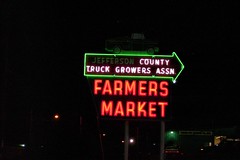Very informative blog post from The Simple Dollar. See www.thesimpledollar.com You can subscribe to their RSS feed or with your email address.The Simple Dollar |
| Ten Ways to Find Bargains on Fresh Food Posted: 16 Jul 2008 03:00 PM CDT
The only problem with this approach to eating is that it’s often perceived as very expensive. If you browse through the food options at your local mega grocery, you’ll usually find that healthy options, like organic fruits and vegetables, free range chickens and eggs, grass-fed beef, organic milk, and so on are usually substantially more expensive than the regular versions of the products. For a family on a budget, that’s a hard one to justify - is someone trying really hard to get by going to spend an extra two dollars a pound for organic carrots versus regular carrots? How about an extra two dollars a gallon for organic milk? It’s not something that fits well into the average budget. The secret, though, is that fresh and healthy food is often just as cheap as the regular stuff - if you bother to do a little bit of looking around. Over the years, I’ve tried all sorts of methods for getting fresher and more healthy food on our table without exploding our food budget. Here are ten tactics that work. 1. Know what’s actually available to you. The 100 Mile Diet Map identifies original sources for fruit, vegetable, dairy, and meat in your area that originate from within 100 miles of your zip code. In other words, it’s a great way to find truly fresh locally grown stuff. LocalHarvest.org finds all sorts of retail sources for locally grown foods all around you. 2. Be adventurous in your food choices. If you have an opportunity to try a new fruit or vegetable or other fresh food at a very inexpensive price, don’t skip it because you’re unfamiliar with it. Instead, pick some up, go home, flip open a cookbook, and try something new - you’ll almost always be glad you did, plus you will have saved some money. I used to avoid okra, for example, but once I tried it in a dish with red beans, rice, and andouille sausage, I was a convert. 3. Shop for produce regularly at farmers markets. The challenging part of a farmers market, though, is that you’ll never be quite sure what you’ll come home with. The selection is completely dependent on what’s in season, and thus you’ll not find preserved and shipped out of season items there. Thus, it’s much more difficult to make a shopping list for a farmer’s market. Instead, when you’re in need of produce, find out when your local farmers market is open and hit that before stopping at the grocery store. Then, use what you buy there as the backbone for your meal planning. Here are some useful tactics for tackling a farmers market for the first time. 4. Use farmer’s markets for information, too. Almost everyone I’ve interacted with at a farmers market is glad to help with all of these questions. Why? First of all, they love this stuff. If they didn’t, they wouldn’t be at a farmers market. Second, they know that providing you with good information will likely make you a happy customer and keep you coming back. So ask. Ask lots of questions. Learn more about the food you’re eating and where to get more of it. 5. Join a CSA. I stopped by to check out how their system works. Basically, you buy a “share” early in the year that costs around $300. This “share” earns you a giant box of produce every week throughout the late spring, summer, and early fall - twenty weeks in all (making the cost effectively $15 a box). The content of the box is basically an equal share of whatever happens to be in season at the moment - early on, it’s heavy on the lettuce, asparagus, and other greens; by mid-summer, there’s lots of tomatoes and corn; later on, you might see squashes and the like. For the volume of food you get, it’s a tremendous deal, especially considering it’s fresh and local. You can use the tools in tip #1 to find your own local CSA. You might also find that some of the people at farmers markets also run CSAs, so they may be able to give you a lead, too. 6. Start your own garden. It’s even lower when you add in the concept of gardening as a hobby when compared to other hobbies. An hour spent in the garden, if you enjoy it, is an hour well spent, never mind the fact that it provides some financial and nutritional benefit over the long haul. 7. Share a garden with someone else. Not only does this provide you fresh food, it also transforms gardening into a social activity that you can share with a friend. Even a medium sized garden can provide a good amount of fresh produce for two families, and with a partner you can spread out the costs of the materials and the effort, too. A win-win all around, and it gets tasty fresh produce on your table. 8. Establish a bartering relationship with someone who gardens extensively. Again, this turns fresh produce into a win-win. Not only is it free for you now, you’ve also got an afternoon at a friend’s house, helping him or her out. Good conversation, an afternoon well spent, and some fresh food later on? You can’t beat it. 9. Use your grocery flyer to identify healthy sales, then plan around them. Since you have the advantage of knowing the fresh produce you’ll have, use it as the backbone for your meal and shopping planning. Find recipes that use these fresh items, then construct a shopping list out of what you need for these recipes. 10. Join your local Slow Food convivum. Slow Food is an organization dedicated to “slow food” - the opposite of fast food. They organize into local chapters (called conviva), where people meet and share ideas about eating locally and often share information online, too. These groups are treasure troves of information on inexpensive, local, fresh produce and well worth looking into if you’re interested in the topic. |
 I’m always on the hunt for fresh food, grown locally and preferably grown organically and with sustainable practices. Not only are such items healthier, they’re also almost always much more flavorful, too. You haven’t lived until you’ve tried a salad made up of greens that were cut less than an hour before.
I’m always on the hunt for fresh food, grown locally and preferably grown organically and with sustainable practices. Not only are such items healthier, they’re also almost always much more flavorful, too. You haven’t lived until you’ve tried a salad made up of greens that were cut less than an hour before.




















No comments:
Post a Comment